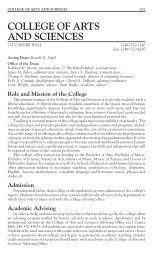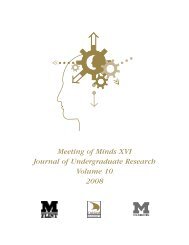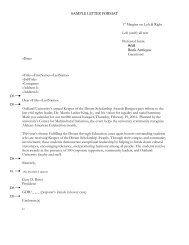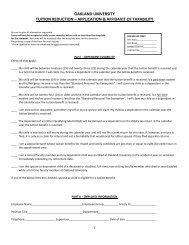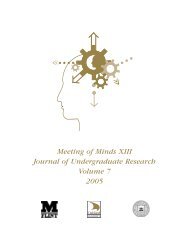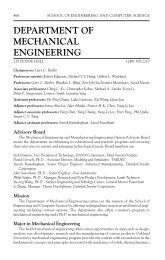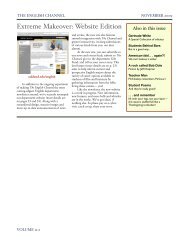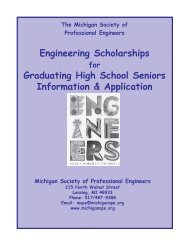MOM 2006 journal for pdf.pmd - University of Michigan-Flint
MOM 2006 journal for pdf.pmd - University of Michigan-Flint
MOM 2006 journal for pdf.pmd - University of Michigan-Flint
Create successful ePaper yourself
Turn your PDF publications into a flip-book with our unique Google optimized e-Paper software.
The computational tool is an alternative and/or support to the experimental research, but theoretical<br />
studies <strong>of</strong> bulky zeolites are limited by computer resources. With the recent development in<br />
theoretical methods, the cluster model can be used to represent the interaction between the adsorbed<br />
molecules (adsorbate) and the zeolite fragments. 18,19,20,21,22<br />
The mechanism <strong>of</strong> adsorption-decomposition <strong>of</strong> NO x<br />
on Cu-ZSM-5 is complicated and involves<br />
many steps. 22 This study focused only on the initial adsorption <strong>of</strong> NO x<br />
– the first step in the<br />
adsorption-decomposition process. Only chemically bonded adsorption complexes may be stable<br />
enough to allow subsequent decomposition reactions. There are 5 possible NO 2<br />
adsorption complexes<br />
and 3 possible NO adsorption complexes. Ab initio calculations <strong>of</strong> the structure <strong>of</strong> these complexes<br />
were per<strong>for</strong>med to determine possible stable adsorption complexes and energy barriers.<br />
Approaches<br />
A cluster model was used to simulate zeolite structures in this project. Zeolite is treated as a small<br />
neutral cluster cut out <strong>of</strong> the bulky crystal structure. Hydrogen atoms terminate the resulting dangling<br />
bonds at the boundary. 23 Two types <strong>of</strong> clusters are examined – hydrogen terminated and hydroxyl<br />
terminated. The hydrogen terminated clusters result from the cluster being cut at the Si-O bond and<br />
terminated with hydrogen (Si-H end group). The hydroxyl terminated clusters result from the cluster<br />
being cut at the O-Si bond and being terminated with hydrogen (Si-O-H end group).<br />
Since the cluster model takes only a very small part <strong>of</strong> the zeolite structure, two important<br />
deficiencies exist. 24 First, the cluster model is different from the zeolite structure, because atoms near<br />
the cluster boundary, arbitrarily terminated by hydrogen/hydroxyl groups, are in different electronic<br />
environments. The second is potential deficiency. A potential is generated from the long-range<br />
electrostatic <strong>for</strong>ces between the cluster model and the zeolite framework, which is missing in cluster<br />
calculations.<br />
Results obtained from cluster model investigations may give us a chance to examine the usage <strong>of</strong><br />
the embedded cluster model. A recently developed embedded cluster model method can be used to<br />
avoid/alleviate a<strong>for</strong>ementioned problems without significantly increasing the computational<br />
costs. 25,26,27<br />
Computational Details<br />
Full optimizations <strong>of</strong> cluster models, from 1T to 10T models (Figure 1), were per<strong>for</strong>med at the<br />
Hartree Fock (HF) and then the Density Functional Theory (DFT) levels with the 6-31G(d) basis set<br />
using the ab initio suite <strong>of</strong> GAMESS package. 28 Additionally, MacMolPlt, a 3D visualization<br />
package, was used to view the optimized geometries. 29 This work was partially supported by the<br />
National Center <strong>for</strong> Supercomputing Applications under CHE060031N and utilized the Copper and<br />
Tungsten systems. All other calculations were per<strong>for</strong>med on a Mac Power cluster.<br />
Meeting <strong>of</strong> Minds <strong>2006</strong> 70



